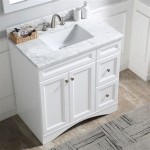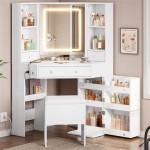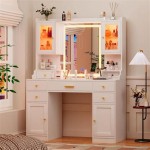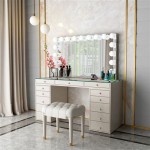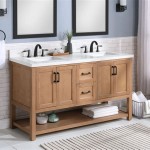Bathroom Vanity and Dressing Table: Functional Elegance in Design
The bathroom and the dressing area, while distinct spaces, often share a common need for functional storage, ample lighting, and a touch of elegance. The bathroom vanity and the dressing table, two cornerstone pieces of furniture, are designed to address these needs. Although their primary functions differ, both contribute significantly to the aesthetic and practical aspects of daily grooming rituals. This article explores the characteristics, design considerations, and functionalities of bathroom vanities and dressing tables, highlighting their importance in modern home design.
A bathroom vanity is fundamentally a combination of a sink and storage. It serves as the focal point of the bathroom, housing the sink, concealing plumbing, and providing space for toiletries, cleaning supplies, and other bathroom essentials. Dressing tables, on the other hand, are primarily designed for grooming activities such as applying makeup, styling hair, and organizing personal care items. They typically feature a mirror, a flat surface, and drawers or compartments for storage.
Key Differences and Overlapping Functions
While the core purpose of each piece is distinct, there are overlaps and design variations that blur the lines. For instance, some larger bathrooms may incorporate a vanity unit that closely resembles a dressing table, featuring a wider countertop area suitable for both sink use and grooming activities. Conversely, in smaller apartments or homes, a dressing table might be strategically positioned near the bathroom to serve as supplementary storage for bathroom necessities.
The primary distinction lies in the built-in sink feature of a bathroom vanity. This necessitates water resistance and specialized plumbing considerations. Dressing tables, not requiring plumbing, can utilize a wider range of materials and design styles. However, both pieces contribute to the organization and aesthetic appeal of their respective spaces.
Design Considerations for Bathroom Vanities
Selecting a bathroom vanity involves a range of factors, including size, style, material, and functionality. The available space in the bathroom is a crucial constraint. Vanities come in various sizes, from compact models suitable for small powder rooms to expansive double-sink vanities for larger master bathrooms. The style should complement the overall aesthetic of the bathroom, whether it be modern, traditional, rustic, or minimalist.
Material selection plays a significant role in both the appearance and durability of the vanity. Common materials include wood (solid or engineered), MDF (Medium-Density Fiberboard), and metal. The countertop material is equally important, with options such as granite, marble, quartz, and ceramic tile. Each material offers different advantages in terms of aesthetics, water resistance, and maintenance requirements. Wood vanities often need to be sealed or finished with water-resistant coatings to prevent damage from moisture.
Functionality is another key consideration. The amount of storage space, the type of drawers and cabinets, and the placement of the sink are all important factors. Some vanities feature open shelving, while others prioritize closed storage for a cleaner look. The height of the vanity should also be ergonomically suitable for the user, preventing back strain and ensuring comfortable use. Lighting around the vanity area is crucial for tasks such as shaving and applying makeup. Integrated lighting or strategically placed sconces can enhance visibility and create a more inviting atmosphere.
Plumbing considerations are paramount when installing a bathroom vanity. The drain and water supply lines must be properly connected to prevent leaks and ensure proper functionality. Professional installation is often recommended, especially for complex plumbing setups.
Design Considerations for Dressing Tables
The design of a dressing table centers around providing a comfortable and organized space for grooming activities. The size and layout of the dressing area will dictate the dimensions of the table. A comfortable seating arrangement is essential, with a stool or chair that allows for proper posture and comfortable reach to the tabletop.
The mirror is a central feature of a dressing table. It can be freestanding, mounted on the wall, or integrated into the table itself. The size and shape of the mirror should be appropriate for the user's height and viewing distance. Adequate lighting is crucial for applying makeup and styling hair. Vanity lights, sconces, or a well-placed table lamp can provide the necessary illumination. Some dressing tables come with built-in lighting for added convenience.
Storage is another key element of a dressing table design. Drawers, compartments, and shelving can be used to organize makeup, jewelry, brushes, and other personal care items. The layout of the storage should be intuitive and easily accessible. Dividers and organizers can help to keep drawers tidy and prevent items from becoming disorganized.
Material choices for dressing tables are often broader than those for bathroom vanities, as water resistance is less critical. Wood, metal, glass, and acrylic are all common materials. The style of the dressing table should complement the overall decor of the bedroom or dressing area. A minimalist design might feature clean lines and simple hardware, while a more ornate design could incorporate intricate carvings and decorative accents.
Materials and Finishes
The selection of materials and finishes significantly impacts the longevity and aesthetic appeal of both bathroom vanities and dressing tables. Solid wood offers durability and a timeless look, but it requires proper sealing and maintenance to prevent water damage in a bathroom setting. Engineered wood, such as plywood or MDF, provides a more cost-effective option and can be treated to resist moisture. Metal frames offer a contemporary look and are often powder-coated to prevent rust.
Countertop materials for bathroom vanities are subject to different considerations. Granite and quartz are popular choices due to their durability, heat resistance, and stain resistance. Marble offers a luxurious look but requires more careful maintenance to prevent staining. Ceramic tile is a cost-effective option that is easy to clean but can be prone to chipping. Solid surface materials, such as acrylic, offer a seamless look and are resistant to water and stains.
Finishes also play a crucial role in both aesthetics and protection. Paint, stain, and varnish are common finishes for wood surfaces. Paint allows for a wide range of color options, while stain enhances the natural grain of the wood. Varnish provides a protective layer that resists scratches and water damage. Metal surfaces are often powder-coated or plated to prevent corrosion and enhance their appearance.
Lighting Solutions for Grooming Spaces
Adequate lighting is essential for both bathroom vanities and dressing tables. Proper lighting ensures that tasks such as shaving, applying makeup, and styling hair can be performed accurately and safely. The type of lighting, its placement, and its color temperature all contribute to the overall effectiveness of the lighting scheme.
For bathroom vanities, task lighting is crucial. Sconces mounted on either side of the mirror provide even illumination that minimizes shadows. Overhead lighting, such as recessed lights or a pendant fixture, can provide ambient light for the entire bathroom. It is important to choose light bulbs with a color temperature that is close to natural daylight (around 5000K) to ensure accurate color rendering. Dimmable lighting allows for adjusting the brightness to suit different tasks and preferences.
For dressing tables, a combination of task and ambient lighting is ideal. Vanity lights mounted around the mirror provide focused illumination for applying makeup. A table lamp or floor lamp can provide ambient light for the surrounding area. As with bathroom vanities, it is important to choose light bulbs with a color temperature that is close to natural daylight. Adjustable lighting allows for customizing the brightness and direction of the light.
Storage Solutions and Organization
Efficient storage is essential for keeping bathroom vanities and dressing tables organized and clutter-free. The type and amount of storage space required will depend on the individual's needs and the size of the space. Drawers, cabinets, shelves, and organizers can all be used to maximize storage capacity.
For bathroom vanities, drawers are ideal for storing small items such as makeup, toiletries, and personal care products. Cabinets can be used to store larger items such as cleaning supplies, towels, and extra toiletries. Shelves can be used to display decorative items or store frequently used items. Drawer dividers and organizers can help to keep drawers tidy and prevent items from becoming disorganized. Consider vertical storage solutions to maximize the use of available space.
For dressing tables, drawers are essential for storing makeup, jewelry, and accessories. Compartments can be used to organize makeup brushes and other tools. Shelves can be used to display perfume bottles or store books. Jewelry organizers can help to prevent necklaces from tangling and earrings from getting lost. Consider using clear acrylic containers to store makeup and other small items so that they are easily visible and accessible.
Both bathroom vanities and dressing tables benefit from regular decluttering. Remove items that are no longer used or needed to create more space and make it easier to find what you are looking for. By implementing effective storage solutions and maintaining a clutter-free environment, you can create a functional and aesthetically pleasing grooming space.

Dream Bathrooms Top 10 Amazing Dressing Tables Maison Valentina Blog

Dream Bathrooms Top 10 Amazing Dressing Tables Maison Valentina Blog

Dream Bathrooms Top 10 Amazing Dressing Tables Maison Valentina Blog

Bathroom Dressing Tables

Custom Made Modern Double Sink Vanity Dressing Table Joseph Kitchen Bath

Master Bathroom Dressing Table Design Ideas

Attractive Mirror Dressing Table Designs For Beginners

Makeup Vanity Dressing Table
:strip_icc()/101780882-9b39f027eeb14758898c2fbf57831742.jpg?strip=all)
45 Gorgeous Bathroom Vanity Ideas That Fit Every Style

Caitlin Wilson L Shaped Master Bathroom Vanity Sink Dressing Table The Glam Pad

